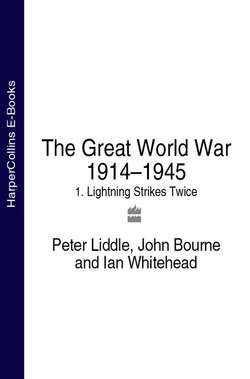Читать книгу The Great World War 1914–1945: 1. Lightning Strikes Twice - John Bourne - Страница 35
Chapter 8 War in the Pacific
ОглавлениеEric Bergerud
Between December 1941 and August 1945 the United States and its allies fought an unrelenting war against the Japanese Empire. Although only one portion of what Japanese leaders called the Greater East Asian War, Pacific operations were certainly the most decisive in the military sphere. Even though more people died in China and South East Asia than in the Pacific, it was Allied victory in the Pacific that determined the nature and duration of the overall conflict.
Although East Asia had been racked by tumult for decades before 1914, it was spared the military ferocity of the First World War. Tsing Tao in 1914, still less Rabaul in the same year, simply do not register on any scale of comparison with the warfare experienced in the Pacific a generation and a half later. Nevertheless, the Great War did much to shape the military geography of the Second World War. Japan seized German possessions in China and the Central Pacific. Many of these islands became battlefields when the US drove into the Central Pacific in late 1943. While Japan was picking German plums, Australia was also active, taking north-west New Guinea and the nearby Bismarck Archipelago, which included the islands of New Ireland, New Britain and Bougainville. Much of this area early in the Second World War fell to Japan. Centred at their great bastion at Rabaul on New Britain, the Japanese developed a base system in the Bismarcks that served as a major bulwark of their maritime defence line protecting the precious resources in the East Indies. Efforts to take or neutralise Rabaul drove on the campaigns in both New Guinea and the Solomon Islands and constituted the major Allied effort in the Pacific for a year and a half.
Inter-war events in Europe also had a crucial bearing on the road to war in the Pacific. Japan’s aggression in Manchuria and later against China would have been unthinkable without the paralysis caused in the Western world by the Depression and later the looming war clouds in Europe. Hitler’s early triumphs accelerated events tremendously. The Japanese Government, controlled by the military and supported by militant expansionists, saw the defeat of France and Britain’s apparent doom as a priceless opportunity to move in and occupy mineral-rich South East Asia, then controlled by the European empires. Because of antagonism over China and the strategic position of the American-controlled Philippine Islands, a move into South East Asia would also almost certainly mean war with the United States. When Hitler struck Russia, again there was delight in Japan. However, the Japanese Army insisted that it keep its core on the Manchurian border to take advantage of a Soviet collapse. This meant that the Imperial Headquarters would part with only 11 divisions for ‘southern operations’, which the army considered the responsibility of the Japanese Navy.
It is important to understand the relationship between the war in Europe and the Pacific War. On the one hand the wars were essentially separate conflicts. Although allies on paper, Germany and Japan never co-ordinated action in a meaningful way. On the other hand, Japan was absolutely dependent upon a German victory. If Hitler went down to defeat, Japan would face a massive array of enemies alone. Indeed, given a German defeat, it is best to view the course of the Pacific War in terms of nature and duration, not outcome. For Japan there was cruel irony in that two days after Japanese carrier aircraft attacked Pearl Harbor, the Red Army launched its devastating counter-attack outside Moscow.
